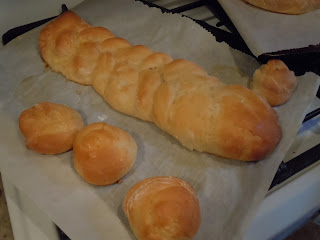As long as you're in the process of getting snowed in, why not cook? Recently, I had to cook up an appetizer/hor d'oeuvre for a small neighborhood party. I realized--I don't really do appetizers. I thought momentarily...I've dabbled in baked brie, tried a bruschetta or two, but I didn't know what I could make that would wow anyone.
But aha! (there's always an aha moment).
I've made big quiches before, so why not give mini quiches a try?
I looked online, but wasn't pleased with what recipes I found. Many called for peculiar things like buttermilk or heavy cream (fun but unnecessary). With the help of my favorite recipe inventor, aka my good ol' mommy, I decided to make my own recipe.
Firstly let me say that this recipe will be slightly more difficult if you don't have a background in working with phyllo dough. So-- a few tips and tricks if you're not familiar with it. If you think you'll be okay, skip reading these.
--Phyllo dough generally comes in rolled up flat sheets. First thing you should do when you bring it home (assuming you're going to begin cooking within the hour) is unroll them on cutting boards and place a damp towel over the whole stack of sheets. Keeping phyllo moist makes it infinitesimally easier to work with.
--Don't insist upon working with one sheet at a time. Phyllo is a series of many thin, thin sheets. Rarely do you need just one sheet. Work with 2/3 at a time, it'll tear less and be way more user friendly.
--Work slowly but with purpose. Phyllo needs to be handled carefully but with a certain swift-ness. If you mess with it too much it'll just tear and you'll have a bad time.
Moving on--the recipe shaped up something like this:
Premade Phyllo Dough
8-9 Eggs
1-1 and 1/2 cup of half and half
2-3 cups of shredded cheese (preferably an orange cheddar)
1 package of frozen broccoli (it was out of season! :p)
Salt, Pepper, Cayenne Pepper/Chili Powder, Garlic Powder, to your liking. Don't be too stingy with the salt though--keep in mind this is basically like making a bunch of scrambled eggs...salts a must.
Prep muffin/cupcake baking pans with a shot of pam/cooking spray in each well.
Beat the eggs with a whisk until fully combined, add in the half and half and beat till combined even more. Spice as you wish.
Place the broccoli either in the microwave or in a pot steaming with some water until cooked through but not soggy or too "fall-y apart-y" as I would totally say.
Now--the work. If your phyllo is on cutting boards as I said earlier, start by taking a knife and cutting the phyllo into squares vertically and horizontally. Each square of phyllo should measure across about a little larger than the diameter of your muffin wells. Then, 2 by two, take squares of phyllo and sort of wrap them into the muffin wells, like they look in the picture below/right. Remember, the less you play with them the better they'll be and the easier they'll be to work with.
Finally, pour in the egg mixture in each cup until about a little more than halfway full. The egg certainly puffs up so I would certainly hesitate to fill them too high or you might end up with a scrambled egg oven.
Let bake for 18-26 minutes or until egg is fully puffy and phyllo is browned on bottoms and tips.
Hope yours turn out as delicious as mine! They were a big hit at the party! Finished quiches bottom right.




























